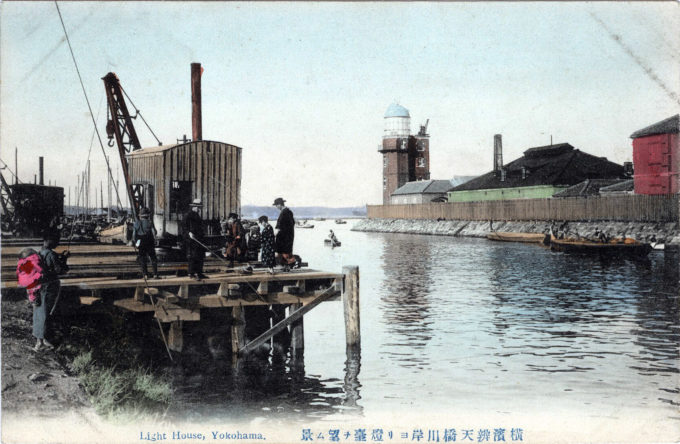
“A view of a lighthouse from the Bentenbashi riverbank”, Yokohama, c. 1910. The history of Japanese lighthouses goes back 1200 years beginning, it is said, with signal fires (‘noroshi‘) lit in the daytime and bonfires (/kagaribi‘) burning at night along the capes of Kyushu. Modern-era lighthouses, using polished lenses and hollow wick lamps, first appeared on the Japanese coast in 1869, with the first thirteen built to light the approaches to newly-opened treaty ports.
One of these early lighthouse still remains standing and in use, at Mikomoto Shima off the coast of the Izu Peninsula near Shimoda, built in 1870 by the “father of Japanese lighthouses”, Richard Henry Brunton, who designed and supervised the building of 26 Japanese lighthouses in the Western style. Brunton also established Japan’s first telegraph link in 1869 (between Yokohama and Tokyo) and help found Japan’s first school of civil engineering before returning to Scotland in 1876.
See also:
Modern Lighthouse, c. 1930.
“People read or speak of a Lighthouse and think no more about it. But they may and ought to learn what an amount of scientific application has been brought to bear on the subject.
“A Lighthouse is more than a mere bright lantern set in a tower. There are reflectors and magnifying glasses, and all sorts of contrivances to make as much light, with the obscuration of as few rays, as possible.
“In each of the Japanese Lighthouses is an apparatus in the tower for measuring the force and showing the direction of earthquakes. There is also one of the late Admiral Fitzroy’s weather gauges; and tables are most carefully kept of all the variations of the barometer and thermometer.
“Indeed in every possible way the Japanese lighthouses will be availed of to supply data that may be useful to the world at large.”
– The Far East: An Illustrated Fortnightly Newspaper, Vol. 1 No. 13, December 1, 1870

